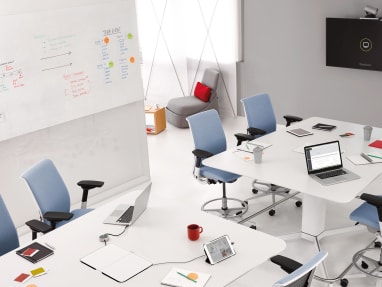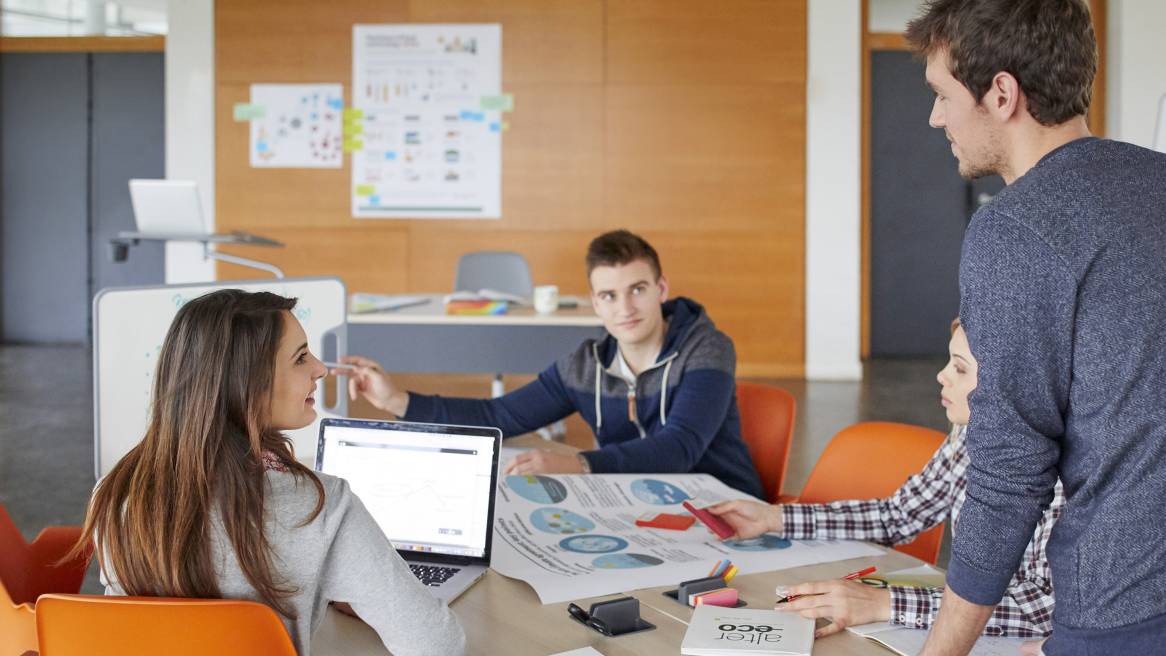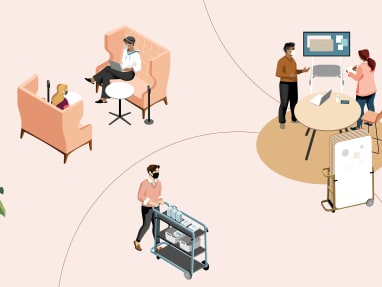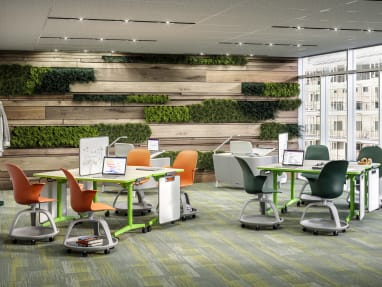Application Ideas
Rethink the Box
Rethink the Box
Node is designed for active learning. Mobile and flexible, Node is ideal for quick, easy transitions from one teaching mode to the next, unlike traditional school desks and chairs.
Open image tooltipPut Control in the Hands of Students + Instructors
These classrooms rethink “the box” and move away from the traditional setting of rows of fixed tablet chairs and a lectern. These classrooms engage and inspire by putting control of the learning space in the hands of students and instructors.
- Here you will find learning spaces that can easily morph from lecture mode to teamwork to group presentation, discussion and back again.
- Every seat is the best seat, with access to content, other students and instructors who are available to everyone.
- Technology is integrated, providing democratic access for all.
Node Classroom
Node Classroom
Node Classroom
This classroom features Node on casters with personal worksurfaces, portable Huddleboards and a height-adjustable instructor table for maximum flexibility and comfort.
- Lightweight Huddleboards are ideal for small group content creation and review. Hang on a workrail or easel for presentation to the class.
- Instructors can position their adjustable table and stool at any point in the room that’s best for their teaching style or activity at hand.
- Personal worksurfaces adjust for large and small users and move independently of the seat shell and base.
- With built-in storage in the base, personal worksurface, swivel seat and casters, Node makes maximum use of every square foot of classroom space.
Verb Classroom
Verb Classroom
Verb Classroom
Verb is an integrated system of classroom furniture designed to support a variety of learning and teaching styles on demand. Verb classrooms give students and instructors limitless possibilities for learning modes with individual, mobile desks to support focused and collaborative work. Learning is extended to vertical surfaces with the interactive and static whiteboard.
- The freedom to move and engage means wall protection is required in all active learning settings.
- Information persistence is supported with wall track at multiple heights for whiteboards
- Seating that swivels and offers height adjustability supports all user types.
- The table’s chevron shape supports the individual’s intimate zone, separating “my” space from “your” space.
media:scape Classroom
media:scape Classroom
media:scape LearnLab
Combining innovative LearnLab design with unique media:scape technology creates the opportunity for three distinct modes of sharing digital content: small team co-creation, group sharing and lecture.
- LearnLab provides multiple stages where instructors can engage with students.
- media:scape integrates furniture and technology to let instructors and students share digital information instantly.
- Small team breakouts occur at the table in the classroom, eliminating the need to move to another location.
- Face-to-face seating encourages student engagement and team collaboration.
- A triangular view plane offers students equal visual access to content, no matter where they’re located in the classroom.
 Open image tooltip
Open image tooltip
media:scape Team Studio
The Team Studio enhances connections between local and remote instructors and students. The sense of connectivity experienced by participants allows for an engaged atmosphere that encourages discovery.
- HDVC access allows teams in remote locations to connect with host classroom.
- The whiteboard supports analog co-creation for the local team.
- Angled tables at stool height give the host classroom easy view of each student.
- The split table gives students space to collaborate in small groups and quickly rejoin as a larger group.
- The unique table shapes enhance communication among remote and in-person participants.
More ABout Media:Scape
As teaching methods evolve, learning has become more interactive requiring spaces where everyone can see and interact with content at a moment’s notice. Media:scape allows democratic sharing of information in a wide-range of learning spaces.
Research + Insights
Observations
Observations
What We Observed
The majority of classrooms in use today were built for traditional, “stand-and-deliver, sit-and-listen” pedagogies in a passive learning setting.
Inflexible layouts and furniture with limited mobility hamper interaction among students, instructors and content; in fact, the environment is the barrier.
Technology access is highly variable from classroom to classroom and often poorly integrated.
Instructors and students cannot easily leverage technology—either built-in or portable – to support problem-based pedagogies and hands-on learning.
Many schools are reconsidering how pedagogy, technology and space can be better integrated for a greater impact on teaching and learning.
What We Heard
“We replaced typical cookbook experiments with guided inquiry exercises that encourage students to think and work as a group rather than follow recipes with predetermined results. These exercises develop skills that better prepare them for future work and give them the tools to help them retain knowledge long after the semester ends.”
-Professor
“I bring a lot of stuff to class. And I use a lot of it—it’s not the old days, when we would just take notes in a notebook; it’s a multimedia and social experience. There aren’t a lot of classrooms that work for me.”
-Student
A Multi-Sensory Approach
A Multi-Sensory Approach
- Research suggests a multi-sensory approach to teaching and learning increases engagement, promotes deeper participation, maximizes student achievement and elevates the idea that learning is fun.
- Steelcase research and other investigations suggest that the engagement and interaction of active learning provide a more effective way to learn than passive learning.
- However, as institutions adopt constructivist learning approaches, they often find themselves limited by density challenges and classroom environments designed for lecture-based instruction.
Physical Space
Physical Space
Every educator wants fully engaged students. But first you have to get and hold their attention in the classroom. Based on the latest research, here are seven insights on how to do that.
Open image tooltipTo fully capitalize on the benefits of active learning, physical space must support and enhance the pedagogies employed in the classroom. Static furniture designed for one-way transmission of information simply cannot support active learning.
Collaborative Work
Collaborative Work
Collaborative work is essential to active learning, suggesting that classroom spaces must be varied and flexible. One-size-fits-all classrooms neglect the modern day needs of educators and students. Different subjects and teaching methods require different mixes of furniture, technology and space. Just as there is a variety of ways in which we learn, there must also be a variety of spaces in which learning occurs.
When focused on active learning, institutions should consider how flexibility and variety work with pedagogy, technology and space to support how learning happens in active learning classrooms.
Movement
Movement
Movement is key to active learning. When students can move about easily, they are more interactive, collaborative, comfortable and engaged in class. The Verb classroom collection reinvents the table-based classroom, allowing easy movement between lecture-based and team-based modes and providing the tools needed for collaboration and group engagement.
Case Studies
Case Studies
Design Tips for New Classrooms
Pedagogy
- Design to support fluid transitions among multiple teaching modes: lecture, team project, discussion, etc.
- Design for peer-to-peer learning.
- Allow freedom of movement for the instructor, enabling frequent interactions and ongoing assessment.
- Support the implementation of professional development to increase adoption of new teaching strategies.
- Set expectations for what an active learning environment looks like— learning is messy, things move.
- Expose students to how these environments enable, support and allow them to take ownership of their learning.
- Support individual learning
Technology
- Design for sharing, leveraging both vertical and horizontal surfaces for display; use projection and interactive surfaces.
- Integrate, use and allow access to BYOD and instructional technology tools and devices.
- Allow for displayed information to be persistent over time.
- Ensure thoughtful planning occurs when selecting technology so the tools are used as intended to enhance outcomes.
- Be intentional about what technologies should be used and how to support pedagogical strategies.
- Incorporate tools that support synchronous and asynchronous learning and collaboration.
- Support learning styles with both analog and digital means to co-creat
Space
- Design for visual and physical access, giving every student the best seat in the house and allowing the instructor and student access to each other.
- Facilitate social learning by designing spaces where students can easily connect and collaborate.
- Design to support quick reconfiguration among multiple modes: from lecture to project work, discussion, test taking and back again.
- Include wall protection for table and chair movement.
- Support a range of postures to enhance wellbeing.
- Integrate the design to support and reflect the educational goals and mission of the institution.













